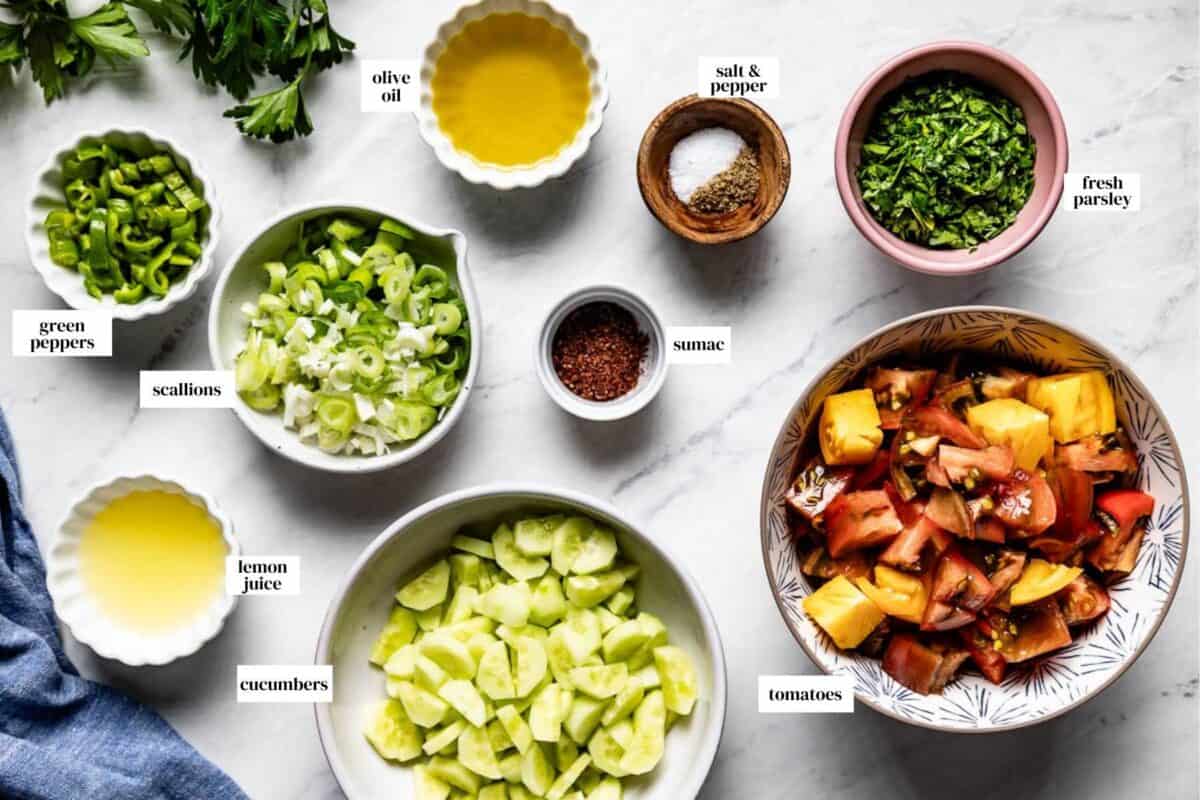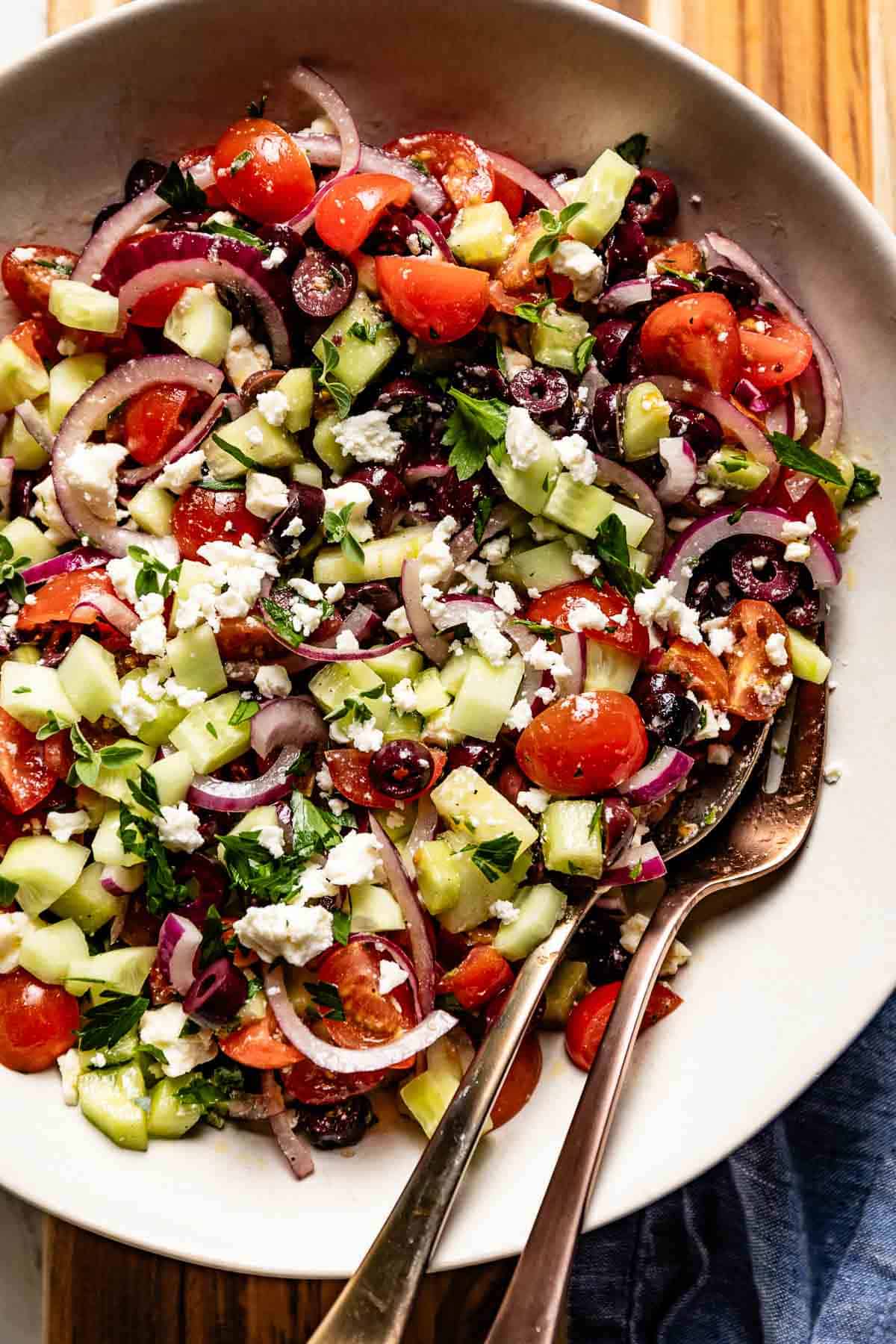What is Shepherd Salad?
If there were such a thing as the easiest salad in the world, Shepherd Salad would probably top the list.
The name may sound a little unusual, but it comes from humble origins. In the countryside of Turkey, shepherds carried simple, inexpensive ingredients like tomatoes, cucumbers, onions, and peppers. Out in the fields, they would quickly chop everything and dress it with olive oil and lemon juice for a fresh, no-cook meal.

Because these were the kinds of ingredients that were affordable and easy to find, Shepherd Salad has always been considered a simple, everyday dish rather than a luxury.
Today, Çoban Salatası remains a staple across Turkey and the Eastern Mediterranean. While it shares some similarities with Greek Salad, Shepherd Salad does not usually include cheese or olives, keeping it lighter and more refreshing.
I left Turkey over 20 years ago, but to this day, I still make this salad almost daily when summer produce is at its peak. It’s one of those recipes that instantly brings me back home.
Simple Ingredients You’ll Need
You’ll only need a handful of fresh vegetables and pantry staples to make this easy summer salad. You can find the full ingredient list in the recipe card below, but here are a few helpful notes from my experience and from how it is traditionally made in Turkey:

Tomatoes: Use the ripest, juiciest tomatoes you can find. Heirloom, Roma, cherry, or even steak tomatoes all work well.
Cucumbers: The authentic Turkish shepherd salad recipe uses Persian cucumbers, which are crunchy and with fewer seeds compared to English cucumbers. However, both types can be used in this recipe. If your cucumbers are freshly picked, it is not necessary to peel them, but I recommend tasting them, as older cucumbers may have bitter skin.
Scallions: I opted for scallions (also known as green onions) for their mild flavor, but finely chopped red onion or white onion can be used if you prefer a sharper bite. If you’re using green onions, you can use both the white parts and the green parts.
Green peppers: Traditionally, this salad is made with a Turkish pepper called sivri biber, a long, slender pepper that can range from mild to hot. Since I can’t find it here in the US, I usually use Anaheim peppers or jalapeños. For a milder option, a green bell pepper works as well.
Lemon juice: For the best taste, use freshly squeezed lemon juice, but in a pinch, bottled juice would also work. You can also swap it with white wine vinegar, apple cider vinegar or red wine vinegar for a slightly different tang.
Olive oil: I recommend using a mild-flavored extra virgin olive oil.
Sumac powder: Sumac is usually available in the Middle Eastern or Mediterranean section of most grocery stores, sold as sumac spice or sumac powder. I often buy mine online, and if you are new to sumac, I really like Eastanbul Sumac Spice.
Just be sure to check the best-by date, as sumac has a shorter shelf life than many other spices (usually around 6 months).
Fresh herbs: I use fresh flat-leaf parsley in this recipe, but you can easily switch it up with whatever herbs you have on hand. In Turkey, it is very common to add fresh mint, fresh dill, or even a mix of the two.
Optional Add-Ins (Modern Variations):
The traditional Shepherd’s Salad is made with just the basics, but you can easily make it your own with a few optional add-ins. Some of my favorites are:
Olives: A handful of olives is a delicious way to make this salad more substantial and filling. In Turkey, we often use briny, firm varieties like Gemlik olives, but Kalamata and black olives work as well. Any olives you enjoy, even simple green olives, will do the trick.
Feta cheese: For the best taste and creamy texture, choose a good-quality feta made from sheep’s or cow’s milk and stored in brine.
Dried mint: In some parts of Turkey, a small pinch of dried mint is sprinkled over the salad for more of an earthy flavor. It is not used in every version, but it is a traditional touch that pairs well with the sumac.
Urfa Chile or Aleppo Pepper: For a little heat, you can also sprinkle in some Urfa Chile pepper, Aleppo pepper, or any red pepper flakes you have on hand. For the most authentic result, aim for a variety that isn’t too spicy so the fresh flavors of the salad can really shine.
How to Make Turkish Shepherd Salad (Step-by-Step Guide)
Making Shepherd’s Salad couldn’t be simpler. You don’t need any special equipment; just a sharp knife, a cutting board, and a bowl. Here’s how to prepare it:

Step 1 – Chop the vegetables: One of the hallmarks of this salad is that everything is cut into small, even pieces. This way, every bite has a little bit of everything. Dice the tomatoes, cucumbers, scallions, and peppers, then transfer them to a large bowl.
Step 2 – Add the dressing: Drizzle the vegetables with lemon juice and olive oil. Sprinkle with sumac, salt, and black pepper.

Step 3 – Finish with herbs: Add the chopped parsley on top. Using salad tongs (or clean hands), gently toss until the vegetables are evenly coated. Tossing gently is key, as it helps keep the tomatoes from getting mushy.
Step 4 – Serve: Enjoy right away while the vegetables are crisp and fresh. Shepherd’s Salad is best served immediately, since the salt and lemon juice draw water out of the vegetables, and the salad can become watery if it sits too long.
Storing Leftovers & Making Ahead
Making Ahead: You can chop the vegetables a few hours in advance and store them covered in the refrigerator. For the best texture, wait to add the dressing until just before serving to keep the vegetables crisp and prevent too much liquid from collecting in the bowl.
Storing Leftovers: Place any leftovers in an airtight container and refrigerate for up to 2 days. Keep in mind that the vegetables will naturally release some liquid as they sit, which will make the salad softer the next day. If that happens, just give it a quick toss and, if needed, add a squeeze of fresh lemon juice to brighten it back up.
Freezing: Freezing is not recommended since the vegetables lose their crisp texture once thawed. For the freshest taste and crunch, enjoy this salad right away.
Expert Tips:
While Shepherd’s Salad is simple to make, a few small details can take it from good to truly authentic. Here are my best tips:
- Use fresh ingredients: This salad depends on peak-season produce. Ripe, juicy tomatoes and crisp cucumbers make all the difference. If your vegetables aren’t in season, sprinkle them with a pinch of salt and let them sit for a few minutes to bring out their natural juices.
- Finely chop the vegetables: The traditional way in Turkey is to cut everything into small, even pieces. This will give you a mix of everything in each bite, and it will also ensure the lemon and olive oil coat everything evenly.
- Season just before serving: Salt and lemon juice draw liquid out of the vegetables, especially tomatoes. So to keep the salad crisp, add the dressing and seasonings right before you bring it to the table.
- Mix gently: Toss the salad lightly with your hands or salad tongs so the tomatoes don’t break down and become mushy.
- Keep it chilled: Shepherd’s Salad is especially refreshing when served slightly cold. If you prep the vegetables ahead, store them in the fridge and dress just before serving.
Delicious Ways to Serve Turkish Shepherd Salad:
The pairing options are endless for this Turkish tomato and cucumber salad. While you can enjoy it with nearly any meal, here are some of my favorite ways to serve it:
- As a side dish: Shepherd’s Salad is a natural pairing with grilled meats like Adana Kebab and Grilled Harissa Chicken, but it also makes an excellent addition to classic Turkish summer dinners such as Karniyarik, stuffed eggplants with ground beef, Ground Beef Stuffed Onions, and vegetables.
- As part of a vegetarian meal: If you want to serve it the way we often do in Turkey, pair Shepherd’s Salad with a bowl of Bulgur Pilaf and a glass of Ayran, the traditional yogurt drink. This is how I’ve enjoyed quick summer lunches for years. Simple, refreshing, and satisfying.
- As a topping for grain bowls: Use it as a light, refreshing topping in dishes like Chicken Shawarma Bowls or Beef Shawarma, paired with rice or bulgur pilaf.
- In a mezze platter: If you want to continue with the Mediterranean flavors, you can serve it in a mezze spread with Pita Bread, or tuck it into Lavash Bread with Hummus for a light and satisfying bite.

Turkish Shepherd Salad Recipe
Ingredients
- 3 medium-sized tomatoes, diced into 1 ½ inch cubes
- 3 Persian cucumbers, peeled and sliced ¼ inch thick
- 2 scallions, both green and white parts, thinly sliced
- 2 green peppers, Aneheim peppers, jalapenos, or serrano peppers – seeds removed and sliced thinly
- 3 tablespoons lemon juice, freshly squeezed
- 3 tablespoons olive oil
- 1 teaspoon kosher salt
- ¼ teaspoon black pepper
- 1 teaspoon sumac
- ¼ cup fresh parsley, chopped
Instructions
- Place tomatoes, cucumbers, scallions, and green peppers in a large bowl or a large platter.
- Drizzle it with lemon juice, olive oil, and season with salt, pepper, and sumac.
- Sprinkle it with fresh parsley and toss to combine.
- Serve it right away.
Notes
- Yields: This recipe makes about 6 cups of salad (depending on the size of your vegetables), and it is ideal for 4 (large) servings. The nutritional values below are per serving.
- Storage: Place leftovers in an airtight container and keep them in the fridge for up to 2 days. It is normal for the vegetables to release their juices as they sit. Just give it a stir before serving.
- Optional add-ins: As I was writing this recipe, I wanted to stay true to the traditional recipe. However, some modern-day versions of this recipe add other ingredients like a handful of crumbled feta cheese, chopped black olives, and a sprinkle of red pepper flakes (or Urfa chile if you can get your hands on.) All of these would be great addition to the recipe.
Nutrition
Nutrition information is automatically calculated, so should only be used as an approximation.
FAQ’s
Both salads feature tomatoes and cucumbers as their base, but they are prepared and served differently. In Turkish Shepherd Salad, the vegetables are finely chopped so every bite has a mix of everything. It’s dressed simply with olive oil, lemon juice, and sometimes a sprinkle of sumac, and traditionally does not include cheese or olives (though you can add them if you like).
Greek Salad (Horiatiki), on the other hand, is made with larger chunks of vegetables and usually includes feta cheese, olives, and oregano, giving it a heartier and more briny flavor.
While it is not traditional, you can sprinkle it with a handful of crumbled feta cheese.
Çoban, pronounced as Chough-bahn, means Shepherd.
Other Turkish Salads You Might Like:
Turkish cuisine is known for similar, easy-to-make salads like this one that you can make during the peak tomato season. A few of my favorites are:
- Summer tomatoes mixed in with white beans and red onions, Piyaz (Turkish White Bean Salad) is yet another simple salad
- At every kebab restaurant in Turkey, you’ll find a side of ezme, and my version shows you how to make this authentic “Turkish salsa” at home with just a few simple ingredients.
This post may contain affiliate links. If you purchase through these links, I may earn a small commission, at no additional cost to you.
















